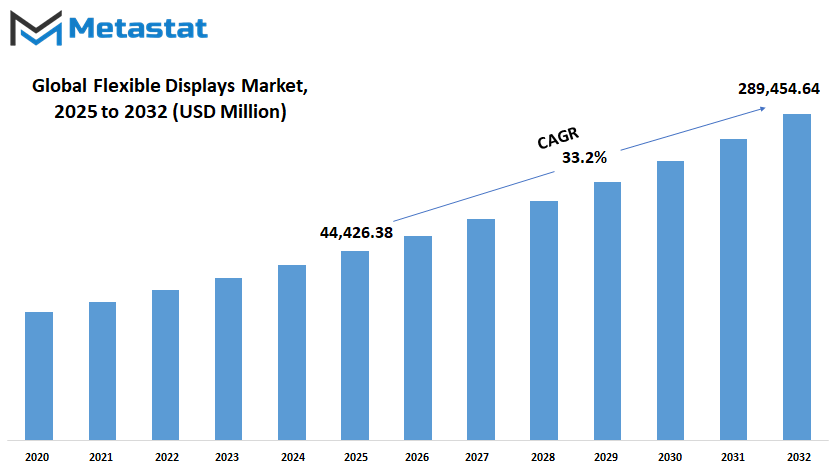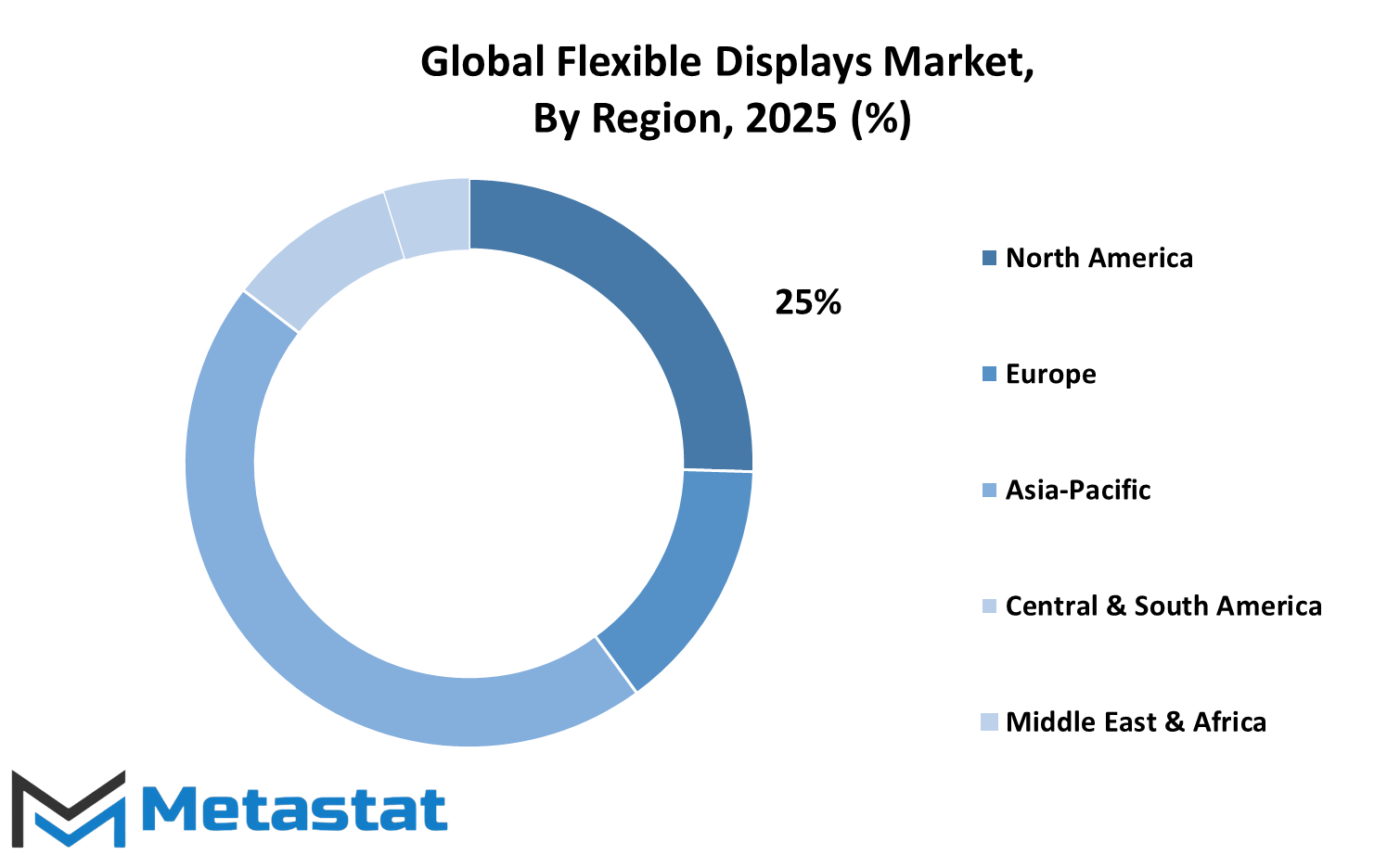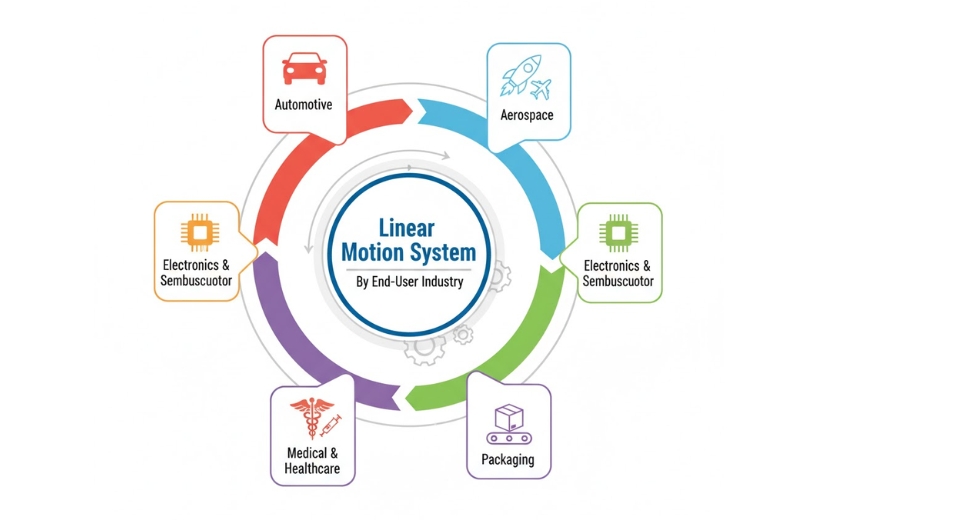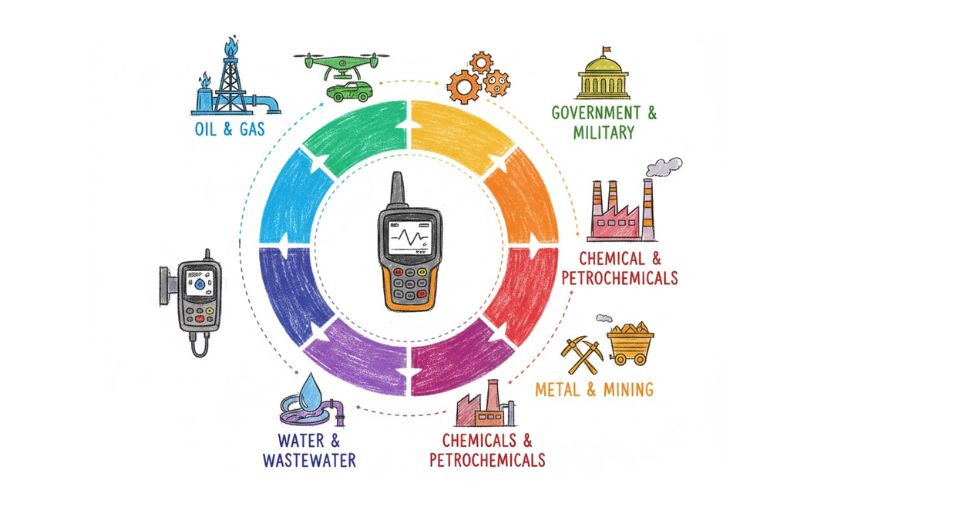MARKET OVERVIEW
The Global Flexible Displays market itself in the industry's advanced electronics and display technology and will cause visualizing digitized information over various applications. It promises display panels to continue working even if bent or folded or rolled, thereby bringing new parameters about device design and consumer experience. As technology advances in display, flexibility in shape would be the normal expectation in various segments, such as consumer electronics, automotive interfaces, and wearable devices, rather than a novelty.
In the Global Flexible Displays market, the emphasis will shift toward the development of materials and components that support mechanical flexibility without compromising visual clarity or device lifespan. Thin-film transistors, organic light-emitting diodes, and next-generation substrates like plastic or metal foils will serve as foundational elements. These components will allow manufacturers to design screens that accommodate curved surfaces, foldable enclosures, or rollable mechanisms, reshaping how users interact with digital interfaces in both mobile and stationary environments.
An influence on industrial design will also be seen in the Global Flexible Displays market, where it will force manufacturers to rethink what used to be structures limiting product innovation. In the continued transition, parameters relating to the dimensions of products will no longer be bound to rigid frames or flat surfaces. That will be the end of all companies testing to find adaptable formats, which will let the devices migrate from one form factor to another, depending on how they are intended or the space they are in. This will influence not only designs but also usage, going as far as compact storage in wearable tech, and all the way to large visuals in fold-out tablets.
Innovations in this market will not be limited to the display itself in the Global Flexible Displays market. Flexibility should be essentially functional, so integration with power-efficient systems and robust touch interfaces complemented with high-end sensors will be necessary. Flexible screen devices have to stand harsh performance criteria such as repetitive folding and exposure to surrounding conditions. Exploration of methods of encapsulating and reinforcing structures will thus continue by engineers and researchers to keep integrity on the side of thin and bending layers with seamless touch display performance.
Moving ahead, supply chains would develop systems to accommodate the novel and unconventional manufacturing processes related to this Global Flexible Displays market. Unlike glass substrates, flexible alternatives necessitate completely different tooling, materials, and assembly methods. But the new fabrication line will support scalability while maintaining quality standards on low-temperature processing and precision layering for special consideration.
Global Flexible Displays market is estimated to reach $289,454.64 Million by 2032; growing at a CAGR of 33.2% from 2025 to 2032.

GROWTH FACTORS
This sector, namely that of Flexible Displays, will completely transform the design, usage, and manufacture of electronic screens. Current changes revolve around the strong interest in lightweight and compact devices that are flexible enough to be folded or bent without losing functionality. Consumers are on the lookout for more portable products that offer a balance between aesthetics and functionality. This growing attention towards foldable cell phones, rollable televisions, and bendable tablet computers shall have a momentous impact on how the market continues to shape itself.
Easy developments in OLED and flexible substrate technologies are perhaps the strongest driving force. These development avenues are paving the way for manufacturers to push further the capabilities of displays-thinner build materials, superior color accuracy, and better energy efficiency have begun to trickle down to flexible displays, which is triggering further brand investment in this space. With increasing improvements being made, these displays will be more reliability and enough capabilities to match the needs of the user. While this is a burgeoning technology, it is being considered with increased credibility to substitute traditional displays in several applications.
On the downside, there exists another set of challenges facing the Global Flexible Displays market. The more complicated and expensive manufacture of these displays by comparative production of conventional screens poses existing constraints. The particulars of the equipment and materials that are being used in the manufacturing processes' parameters, moreover, appear to be generally quite stringent and often expensive. Furthermore, going back and forth on the discourse of modes and durability of such screens in handling stressing regimes-warranty worthiness is creating some sluggishness in the sector, more so where long-term reliability stands at the forefront.
Nevertheless, the hype for flexible displays is expected to find a viable application in quite a few new markets. Wearables like fitness bands and smartwatches favor displays that adapt to the human body. Curved dashboards and smart mirrors are sprouting in automotive, while shaped displays fit for various surfaces in signage and advertisement afford exciting creative possibilities. As further industries discover the merits of flexible displays, demand should continue increasing steadily. At its heart lies continuous innovation and resolution of current challenges, which should take the Global Flexible Displays market into a wealthy future with full growth potential.
MARKET SEGMENTATION
By Display Type
The global flexible displays market is expected to grow in a steady way because markets are searching for lighter, thinner, and more customizable display technologies. Flexible screens are going beyond being seen as design features; they are becoming a necessity in developing new experiences for multiple sectors. Be it foldable smartphones or wearable devices that curve around the wrist, the future will heavily depend on how adaptable and durable these displays could be. Interest in technology is pushing companies to invest more in research that is only going to bring even more advancements in terms of performance and design.
Looking for the display type, it is no surprise that OLED technology is leading the market. Priced at USD 27,166.73 million in 2025, OLED displays will be the most-wanted displays as they provide bright colors, deep contrast, and higher flexibility. Because OLEDs are thin and bendable, they can fit into places where traditional displays cannot, making them ideal for innovation. With devices rapidly moving toward foldable or rollable designs, OLEDs will surely be at the forefront of that revolution.
LCD displays shall still have a share in the Global Flexible Displays market in terms of devices that place very high emphasis on cost as opposed to design flexibility. Although not as flexible as OLEDs, LCDs are quite capable and yet will still be hanging on for many devices when bending is not necessary but would still benefit from a thinner or curved screen. The value is thought to approximate USD 11,006.64 million by 2025, evidence that this type still has a pretty well-established market.
Another type of display is advancing, namely EPD, electronic paper display. It is expected to be worth USD 4,258.27 million in 2025. EPD is identified with eyes friendly, very low power consumption, and is mostly used in e-readers and some digital signs. However, in the future, EPD could also be viewed as going into more products because the majority of users prefer energy-efficient devices.
Finally, there are also other display technologies that were included in the study. This set is expected to reach a revenue of USD 1,994.74 million in 2025, reflecting the fact that there is space for gaining new kinds of displays, which could provide better characteristics, like durability improvement, stretchable materials, etc. As the Global Flexible Displays market continues to expand, it is likely that these will take more significance in the not-too-distant future, progressively pushing limits and making it possible to create devices that were only imagined a while ago.
By Material Type
The global flexible displays market is now geared in a way that would it spend its future changing the user needs, advanced materials, and increasing demand for lightweight and highly durable screens. The most influential force behind this transition is related to the materials used for manufacturing such types of displays. As modern designs strive to take screens beyond conventional boundaries, the material becomes more than just a part of the display and assumes a central character in the performance of the product. Regarding the future of this market, it becomes clear that glass, plastics, and metals will each play a role in how flexible displays will evolve and be applied.
Display technology involves glass since its inception and value spans into the flexible area. Traditional glass may not bend, but new types of ultra-thin, specially treated glass are developed to give maximum strength while allowing a bit of movement. It also falls into an interesting space of clarity and durability. These companies are looking for glasses that can deal with repeated bending and yet provide a clear view, giving improved glass options a likely spot in the flexible display market.
Plastic: It is one of the most talked-about materials in this part of the world. Its lesser weight and its resistance to bending without breaking give it a stronger base for integrating much more portable, sturdy, light devices. Gradually, the quality which was used in making plastic for displays has improved, keeping in mind the association with scratches and color changes. The need for foldable phones, rollable screens, and portable devices will inspire future products with plastic leading the way for much higher flexibility with cost-effectiveness.
Although metal is less used than glass and plastic, it is also being considered for research based on its unique properties. Thin layers of metals can provide a certain strength, seating them within some flexibility. They might never be the first choice for every device but in certain uses where both protection and slimness are required, metal could become more important. As researchers and companies continue to test new blends and coatings, metal-based materials may open up new design paths in the Global Flexible Displays market.
Going forward, it is clear that the material choice will influence not just the appearance of flexible displays but also how long they last, their feel to users, and the environments in which they can be used.
By Panel Size
This Global Flexible Displays market is on the verge of continual growth as technology is now directed at being more convenient, sturdy, and inspiring. Demand for lightweight, bendable, and energy-efficient screens leads towards newer applications of this market from different devices to new industries. This market is usually organized by panel size; every size range creates its own chances for future usage.
Inside the 6-inch panel size range, the use is up to smartphones, smartwatches, etc., including other portable gadgets. Smaller ones let curved or foldable screens be created for a much more compact experience without sacrificing the space occupied by displays. With the advancement of mobile technologies, people will demand more from their devices in terms of performance like having better visuals, a longer battery life, and superb handling. Flexible displays are manufactured thinner and lighter but strong enough to last longer. With the advent of new designs, which will become popular each day, and as competition among tech companies spreading out into every corner to provide and offer the distinct feature, this category will forever be at the forefront.
A section of the panel that has a long extension from 6 to 20 inches would be an important range for tablets, foldable laptops, and gaming tools. These devices would exploit the advantage of rollable or foldable screens for saving space when portability becomes more important to the users. Developers have also been inventive in designing new applications using these displays, from dual-screen devices to foldable computers about the size of a notebook. In the years to come, the panels may find application in educational tools too, making learning more interactive and adaptable to condition.
Panels above that range, say 20-50 inches in a house, are being scrutinized for digital signage, smart home displays, or even vehicle dashboards. Screens within this size range are likely to become possible in home and business spaces as the display quality increases and as the users have to seek more clean and neat designs. Flexible displays above 50 inches promise to offer many facilities to future inventiveness. These larger panels shall be found in public spaces, developed home theaters, and even as part of architecture. The flexibility of being able to install screens that can curve or flex gives much more freedom to designers and engineers. As technology improves in screen resolution and energy and durability, large flexible displays could become a surprisingly everyday matter of life in shaping how people interact with technology and with space.
By Application
The Global Flexible Displays market is bound to flourish as the technology transitions to highly portable, lighter, and more flexible screens. Flexible displays can be defined as the center point when industries choose to focus more on user-friendly and space-saving design. More so, flexible displays are going to change the submission of people toward the interaction they have with devices. They will not only be about bending or folding; it will represent a transformation in the way screens are being constructed to the new needs in daily life. By looking at the different ways flexible displays are used, it becomes clear that this market will spread across many fields, each pushing the limits of what screens can do.
Flexible screens will lead to revolution in the smartphones and tablets section for making the devices roll or fold enabling users to carry huge screen space but in a much smaller form. This is going to enable more mobility while creating innumerable designs opportunities for companies engaged in technological advancements. This will make the smartphones and tablets likely to be very flexible as users would be looking out for devices that can suit their current fast tracked lives.
Amazing changes will also be brought in the area of TV and digital signage applications. Flexible displays will integrate features of reduced footprints by allowing the screen to be bent to various surfaces such as curved or even rolled into a small space for easy storage. This probably alters the way screens in homes and public spaces could be accommodated as per the requirements of changing display size or position. It would benefit advertising a lot as flexible digital signs will be found hanging in previously inaccessible areas for traditional displays.
Flexibility in displays will also be applied in the automobile and transport industry for purposes of both function and design inside vehicles. Dashboards and control panels will be shaped according to the layout of each car, thus making information easily visible while driving. These screens will also become useful by making them shock or vibration resistant as moved by vehicles. The importance and requirement for displays styled in sleek yet sturdy fashion will only increase as vehicles become smarter.
They would be put to use in smartwatch, wearables and e-reader applications. These gadgets will get thinner, much lighter and shaper, and more purposefully hang very easily in providing useful information on the move. Though tracking health, communication, or reading gradually heads toward smaller devices, flexible screens would ensure that very easily manipulable features are visible and used. Looking ahead, other applications might emerge out of the box as newer concepts in fashion, education, or home technology find imaginative avenues to utilize flexible display capabilities.
|
Forecast Period |
2025-2032 |
|
Market Size in 2025 |
$44,426.38 million |
|
Market Size by 2032 |
$289,454.64 Million |
|
Growth Rate from 2025 to 2032 |
33.2% |
|
Base Year |
2024 |
|
Regions Covered |
North America, Europe, Asia-Pacific, South America, Middle East & Africa |
REGIONAL ANALYSIS
The end of the flexible displays market is by then bright clear for the future with displays not only thinner and lighter, but most importantly flexible enough for different types of applications and environments. This technology, which was originally designed for novelty, is now, as part of its journey through, seeing much adaptation into everyday uses moving from items such as mobile phones and tablets to wearables and larger displays. These changes will take various forms, according to the regions of the world, as they help shape the market's going place and speed.
In North America, the plan will focus on innovation and practical use cases. As it has always been the wonderful proponent of tech advancements, with their traditionally embracing culture toward flexible displays, countries like the U.S. and Canada will probably lead in their experiment adopting flexible displays into different sectors. These cover consumer electronics enhancement applications such as into automotive dashboards and healthcare devices, and still be at the front in experimenting with novel uses. Mexico too, with a growing technology manufacturing segment, might witness increased participation, especially since more companies are looking to diversify production bases.
Europe will continue to fuel the flexible display market with its commitment to sustainable design and user-centered technology. Such powerful countries as Germany, the UK, and France would have had strong foundations in research and product design, thereby contributing to the greening of innovative and responsible applications of new products on the development of durable, energy-efficient displays. In the midst of institutional support and tech-savvy population within Europe, it will thus not just contribute to the market by consumption but also through thoughtfulness development.
Asia-Pacific is expected to be the busiest region, led mainly by countries like China, South Korea, and Japan. It already has proven its credibility in electronics manufacture and is home to great names in the field of display technology. These countries will surely not fail to meet the demand, with the objective of expanding the application of flexible displays. However, India, which has a large market and an increasingly progressive attitude toward affordable yet advanced technology, is expected to join the wagon as well.
Slowly, interest in flexible displays in South America might increase. The use of these products would likely find Brazil and Argentina as their main adopters, and only when prices get more realistic would many consumers turn to new, modern technology for personal and commercial business. The Middle East and Africa will progress as well, introducing flexible displays in sectors such as education and communication, especially in countries pursuing digital transformation. Although not a bright prospect in terms of production, these regions will be important in deploying the technology in fresh territories.

COMPETITIVE PLAYERS
The Flexible Displays Market is heading towards a future with great scope for innovations in this area where adaptability and lightweight technology would have a real impact on how people will soon interact with screens in their daily lives. It is indeed interesting how these industries keep looking for more durable, energy-efficient, and better user-friendly solutions in display technologies. But companies in the flexible displays space are really gearing up for stiff competition and emerging demand. Most top players in the industry have already continued pursuing research and product quality, while expanding their reach to applications other than conventional use.
Samsung Display Co., Ltd. and LG Display Co., Ltd are leading this race. They hope to broaden the uses of such screens beyond the scope of the company, even looking for areas such as applications in wearables, foldable phones, and smart systems at home. Their advantage is that their capability allows bulk production, which is yet another impetus by which to push all others in the industry. ROYOLE Corporation, on the other hand, is building up an image by featuring unique designs while bringing its emphasis on portability and user convenience.
FlexEnable Ltd. and AU Optronics Corp. are also knocking on possibilities beyond just having glass, directing their thoughts on creating bendable screens using more flexible plastics, which would, thereby, allow thinner screens and screens that could even be bendable. Researches which are expected to influence future designs in electronics, particularly in devices where rigid screens prove too heavy, or take up too much space, to be practical are underway. Meanwhile, Sharp Corporation and Innolux Corp. continue to work on displaying higher resolution and brightness, alongside increasing the durability of their display products.
Visionox Technology Inc. and Nippon Electric Glass Co., Ltd. have started probing into new ways of making layering and flexibility in displays without compromising image quality. Both E Ink Holdings Inc. and Universal Display Corporation are on their way as they focus on energy-efficient displays, which is a very critical concern in the mobile technology environment. Some of these include Philips, DuPont, and Plastic Logic, working closely with technology companies to integrate flexible displays into new products, such as health monitors and digital signage. It's quite some time in the game for TCL Electronics, along with Himax Technologies, Sony, and Toshiba, all of which continue to invest into next-generation smart screen solutions.
So, as everyone progresses, the Global Flexible Displays market would have more partnerships joined together, with quicker product turnovers and more industries-within industries adopting the technology". What seemed, at once, coveting the future is becoming quite commonplace.
Flexible Displays Market Key Segments:
By Display Type
- OLED (Organic Light Emitting Diode)
- LCD (Liquid Crystal Display)
- EPD (Electronic Paper Display)
- Others
By Material Type
- Glass
- Plastic
- Metal
By Panel Size
- Upto 6”
- 6-20”
- 20-50”
- Above 50”
By Application
- Smartphones & Tablets
- Television & Digital Signage
- Automotive & Transportation
- E-reader
- Smartwatches & Wearables
- Others
Key Global Flexible Displays Industry Players
- Samsung Display Co., Ltd.
- LG Display Co., Ltd.
- ROYOLE Corporation
- FlexEnable Ltd.
- AU Optronics Corp.
- Sharp Corporation
- Innolux Corp.
- Visionox Technology Inc.
- Nippon Electric Glass Co., Ltd.
- E Ink Holdings Inc.
- Universal Display Corporation
- e-Paper Innovation Ltd
- Koninklijke Philips N.V.
- DuPont
- Plastic Logic
- TCL Electronics Holdings Limited
- Himax Technologies, Inc.
- Toshiba Corporation
- Sony Corporation
WHAT REPORT PROVIDES
- Full in-depth analysis of the parent Industry
- Important changes in market and its dynamics
- Segmentation details of the market
- Former, on-going, and projected market analysis in terms of volume and value
- Assessment of niche industry developments
- Market share analysis
- Key strategies of major players
- Emerging segments and regional growth potential







 US: +1 3023308252
US: +1 3023308252






